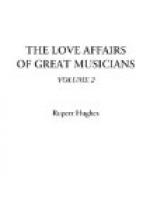The artistico-ecclesiastical life, or, as the German puts it so much more patly, “das kloesterlich-kuenstlerische Leben,” began to wear upon him. For a time Liszt remained in Rome, taking a dwelling in the Via Felice; later, in June of the year 1863, he moved to the Oratorio of the Madonna del Rosario, where the Pope, Pius IX., visited him to hear his miraculous music. He saw the princess often, usually dining with her, and letters fluttered thickly between his home and hers in the Piazza di Spagna, and later in the Via del Babuino.
Liszt was never a man for one of your gray existences. He was homesick for Weimar, and was a constant truant from Rome. But he had duties enough with his ambition as a composer and conductor, and his cloud of pupils whom he taught without price. To his excursions we owe four volumes of letters to the princess. The volumes average over four hundred pages each of smallish type. They are in French, and have been all published, the last volume appearing in 1902, under the editorship of La Mara. Also a publication of the princess’ letters has been announced by her daughter, who wisely believes that in a matter which has become the gossip of the world, the best defence is the fullest possible presentation.
In Liszt’s letters there is not much of the grand style he had affected after his first elopement with De Laprunarede, though there is much that is hysterical:
“How it is written above that you should be my Providence and my good angel here below! I incessantly have recourse to you with prayers, supplications, and benedictions.”
“My words flow always to you as my prayer mounts to God.”
“Since I must not have the bliss of seeing you again this evening, let me at least tell you that I will pray with you before I sleep. Our prayers are united as our souls.” (Nov. 4, 1864)
“Next to my hours in the church the sweetest and dearest are those I spend with you.” (Feb. 18, 1869.)
“My ancient errors have left me a residue of chagrin that preserves me from temptation. Be well assured that I tell you the truth and all the truth.” (Nov. 10, 1870.)
But to attempt a quotation from these letters would be like proffering a spoonful of brine, and saying, “Here is an idea of the ocean.” The letters are full of minute details of their busy lives and of other notable people. There is much, of course, about music and travel, and a vast amount of religious ardour. There is also much expression of the utmost devotion and loneliness. Years of this life of reunion and separation went on.
Writing to the princess on the 21st of June, 1872, he mentions Wagner, whose marriage to Cosima von Buelow (nee Liszt) scandalised the world and alienated even Liszt. There are biographers who deny this, but in this letter to the princess, Liszt encloses Wagner’s letter of most affectionate appeal for reconciliation, and with it his answer, giving his long-withheld blessing. Describing this reunion with Wagner, Liszt is moved to say to the princess:




